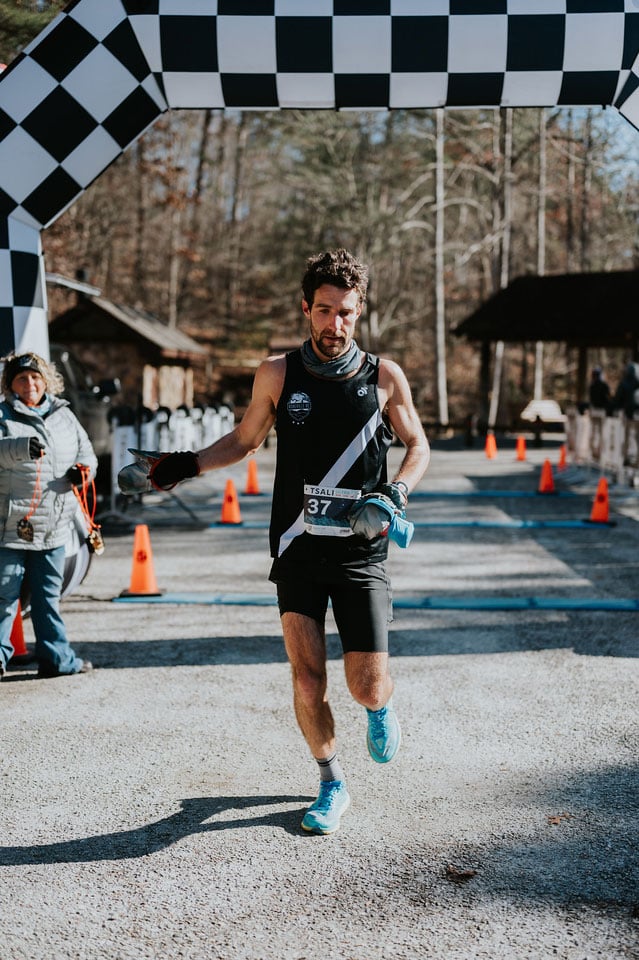by ANNE LUNDBLAD
I hate to stretch. Given an extra ten or fifteen minutes, I’d much rather add another mile or two to my run than stand around in silly (not to mention uncomfortable) poses. My husband, on the other hand, is religious about it. Even in the foulest of weather, he’ll stand around outside after a run, tired and freezing, practicing the stretches that he swears keep his longstanding Achilles problem at bay. Fortunately, we’ve agreed to disagree. He’s given up on chiding me for not stretching, and I’ve stopped informing him that he’s wasting his time. Imagine my excitement, then, when I stumbled across a recent article in The New York Times indicating that perhaps stretching isn’t as necessary, or even as helpful, as most runners believe. Finally, the chance to prove my point once and for all.
Most runners have been taught that stretching is an important part of their exercise regimen. High school coaches espouse the practice, and running magazines are filled with models demonstrating the best stretches for each muscle group. Almost instinctively, athletes stretch sore or tight muscles. Yet medical researchers have found the practice does little to prevent injury and that some forms of stretching, particularly bouncing stretching, are more likely to cause injury than to prevent it. In fact, stretching with bad form or cold, tight muscles is the third leading cause of injury in runners.
In 2004, the Centers for Disease Control and Prevention published a review of 361 scientific articles on stretching. They found that a warm-up prior to activity and regular strength and balance-building exercises are more helpful to athletes than stretching. While they recognized that stretching does increase flexibility, they noted that increased flexibility does not necessarily prevent injuries and that few athletes actually need extreme flexibility. Since most injuries happen when the muscle is going through its normal range of motion, having an increased range of motion has no effect in preventing such injuries.
In fact, several studies have found that extreme flexibility is actually bad for runners. Dr. Malachy McHugh, director of research at the Lenox Hill Hospital Nicholas Institute of Sports Medicine and Athletic Trauma in Manhattan, looked at flexibility and running efficiency in 100 athletes and found that the most efficient runners were actually the stiffest. Another study on military recruits found that trainees with the highest and lowest flexibility had the highest injury rates. This could be because the purpose of static stretching is to elongate muscles. Over-stretching can weaken the muscle-tendon connection. Over time, this can produce weaker joints that are more susceptible to injury.
David Lalley, Ph.D., studied over 1,000 marathoners and found that 47% of those who stretched were injured during a one-year period, compared to 33% of those who did not stretch. He also discovered that those who stretched before running had a higher injury rate than those who stretched after a workout.
Proponents of stretching, however, list many benefits of the practice. It helps to reduce stiffness, making the muscles more pliable and supple. Increased range of motion can help to lengthen stride, especially helpful in downhill running. Stretching can also help to flush lactic acid out of muscles and break up scar tissue from chronic injuries.
Andy Rudins, M.D., an orthopedist at Southeastern Sports Medicine in Asheville, believes in stretching but advises that it should be done at different intensities before and after running. “Prior to workouts or races, the stretches should be fairly gentle, with the goal of reaching your normal “warmed-up” muscle length. After workouts, when you are fully warmed up, more aggressive stretching can be done, with the goal of increasing your normal flexibility.”
Maggie Everett, a physical therapist and ultrarunner in Asheville, also recommends stretching for her patients. She advises athletes to stretch after exercise, when their muscles are warm, noting that muscles that are not stretched tend to shorten and tighten. She cautions, however, that stretching is not a cure for an injury and that “stretching should not be painful, ever.”
So with all of this conflicting information, what’s a runner to do? While the final verdict on stretching is out, it seems to be a matter of personal choice. We each have different bodies with diverse needs. So I guess my husband can continue with his stretching routine, while I focus my energy elsewhere. If stretching feels good for you, do it. If you’re like me and don’t particularly care for stretching, put that time into some warm-up and balance exercises instead.
• Don’t neglect the warm-up. Get the blood flowing through those muscles by starting with a nice easy jog at about 50 percent of your normal intensity. This loosens the muscles and prepares them for the workout to come.
• Don’t stretch cold muscles. If you’re going to stretch, wait until after exercise, using your stretches as a way of relaxing muscles that have tightened during your run.
• Avoid bouncing. Most experts believe bouncing during a stretch is dangerous because the muscle may reflexively contract if restretched quickly following a short relaxation period.
• Don’t force the stretch to the point of pain. You should stretch until you feel slight pulling but no pain. As you hold the stretch the muscle will relax. As you feel less tension you can increase the stretch again until you feel the same slight pull. Rudins recommends holding a stretch for 30-60 seconds.
• Be careful when stretching a sore spot. It may feel good, but could be actually worsening a pull or tear. Consult a sports medicine professional to determine the best way to treat an injury.







